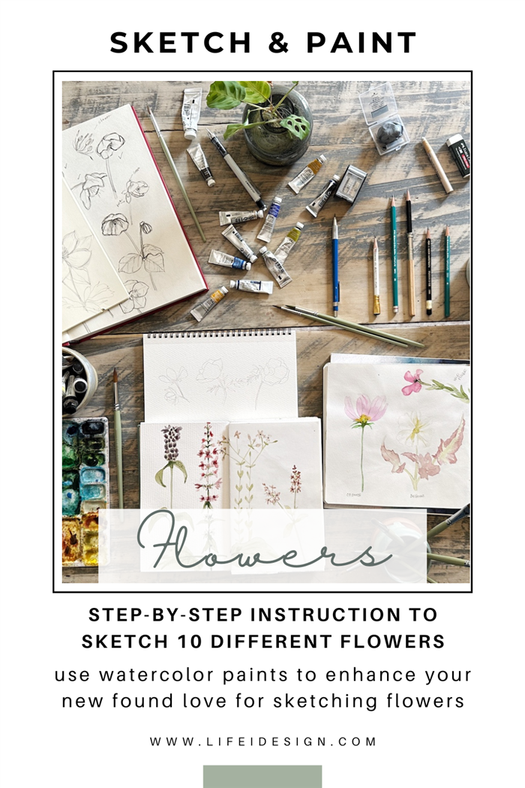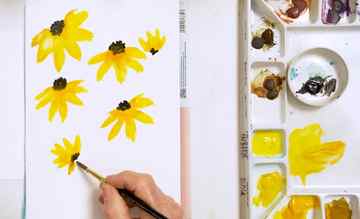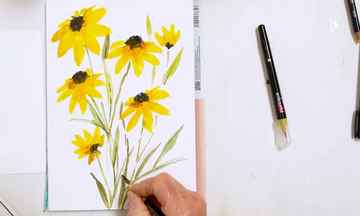Then use a darker shade of green to paint the leaves. Here’s a handy color mixing tip: adding black to yellow can create a beautiful deep green color, perfect for painting flower leaves.
Sketch & Paint Flowers Made Simple – Learn to sketch 10 different flowers with examples of how to paint them too.

This is an electronic version of the Sketch and Paint Flowers. A printed version will be available on Amazon in September.
Sketch & Paint Flowers Made Simple takes you step-by-step how to sketch ten different varieties of flowers in multiple ways. Taken directly from Nicki Traikos’s sketchbook, you will learn to sketch botanicals such as cosmos, daisy, iris and peonies. With each example, Nicki shares pages from her own watercolor sketchbook of the florals painted and lists which colors she used.
This new book will help you examine flowers, draw them loosely so you can add paint and detail using your watercolor paints. Designed with the beginner in mind, practicing the same flower over and in unique ways will help grow your sketching skills and confidence that will spill over to your watercolor painting. Note: This book is not an instructional painting book, but an instructional, step-by-step guide designed to help you sketch flowers more.
Flowers you will learn how to sketch;
- Anemone
- Cherry Blossom
- Cosmos
- Daisy
- Forget-Me-Not
- Foxglove
- Hellebore
- Iris
- Pansies
- Peony
With step-by-step examples, photos from Nicki’s personal sketchbook, and photos of flowers that you can further explore and sketch, Sketch & Paint Flowers Made Simple will help grow your sketching skills and confidence.
From the Author of Watercolor Made Simple, Trace & Paint Botanicals, and Trace and Paint Nature. Nicki Traikos is the founder of life i design where artists can explore a variety of online art classes, books, and resources to help guide their artistic journey. For more information visit www.lifeidesign.com.
You will not receive a physical book as this is a digital product. Once your purchase is confirmed, you will receive a link to download the book and are able to save it, print it and use it for personal practice only.
Watercolor Painting Idea For Beginner- Flower Painting Step By Step-by Diane Antone
Flower watercolor painting are popular among artists, and today, we have the pleasure of learning how to paint Black Eyed Susans with Diane Antone.
Whether you’re a beginner or looking to enhance your skills, this lesson is a perfect opportunity to join Diane Antone and embark on a creative journey as we learn to paint Black Eyed Susans in watercolor.
Materials:
- Colors: MEEDEN Watercolor Paint Set-lemon yellow, pale yellow, gamboge, orange yellow, burnt umber, black,
- Paper: MEEDEN Watercolor Paper Pad, cold pressed, 100% cotton
- Brushes: Round watercolor brushes
- Palette: Watercolor ceramic palette
- Others: Watercolor pencil, water container, paper tissues, fineliner

Step 1: The first step is to sketch the outline using a watercolor pencil, giving a rough shape. I used a yellow watercolor pencil to line out the shape of flower. This way, after applying color, the linework will blend with the pigments. I hope you could see the outline, since the color I use is lighter. It may not be well pronounced. Let just move to the next step.

Step 2: I use gamboge and pale yellow to mix the color for the petals. Shape the petal with the outline, and use orange to show the shadow of the petals.

Step 3: Use a little bit of brown with black to create the color for the flower’s center. Quickly dab the shape of the stamen with the brush. Then, deepen the shadow of the flower using a little bit of brown.

Step 4: Use the same technique, paint the other flowers. Deepen the center and shadows of the flowers with a shade of orange.

Then, use the same technique to dab the shape of the stamen.

Step 5: Use green and yellow to create the color for the branches. Then, use a smaller round brush to gently outline the stems of the flowers.

Then use a darker shade of green to paint the leaves. Here’s a handy color mixing tip: adding black to yellow can create a beautiful deep green color, perfect for painting flower leaves.

Step 6: Let the painting dry for a while, then use a fineliner to outline the flower centers. Make it fuzzy.

Step 7: Gently trace the leaf veins with a deep green color, feel free to let your strokes flow naturally.

Now you get a beautiful flower watercolor painting!

You could see the detailed video here:
To learn more watercolor painting ideas you could visit the YouTube channel of Diane Antone @DianeAntoneStudio and her website.
If you’d like to learn more about painting and related topics, feel free to leave a comment in the section below. We’re more than happy to provide you with additional fascinating learning resources and painting materials.





